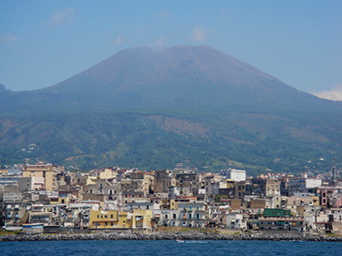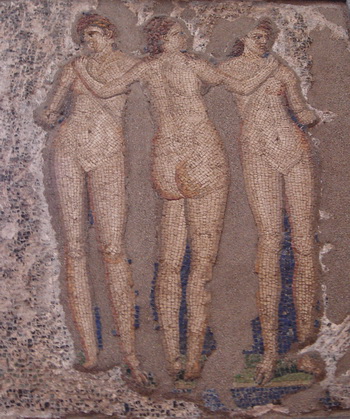
Naples, Pompeii
and Herculaneum
August 2008
Part Two
| |
| HOME |
| About Tenaya |
| About Us |
| Latest Update |
| Logs from Current Year |
| Logs from Previous Years |
| Katie's View |
| Route Map |
| Links |
| Contact Us |
![]()
August 7, 2008
Naples and the surrounding area has always intrigued me. My parents and brother lived here for a while in the late 50s while my dad was working for the U. S. Government. My mother told me she could see Vesuvius and Capri, which she always pronounced correctly, from their rented home. She had fond memories of the city and I've always felt a little cheated for being born too late. As a little girl I was fascinated reading their souvenir books on Pompeii and Vesuvius.

Vesuvius rises above Torre del Greco
There are many marinas around the Bay of Naples and on the nearby islands. We chose to stay at Torre del Greco because of its proximity to the sites. The Pilot Book says that security had lapsed so we were a bit concerned but decided to have a look. We motored in searching for a visitors quay, a fuel quay (always a good alternative) an office or an official looking guy somewhere. Nothing. I called them on the radio. Nothing. We jilled about for 20 minutes waiting for someone to notice us and eventually two men did. They motioned for us to tie up at the club quay adjacent to the jetty on the convenient side of the harbor. They helped us with the lines tossing us two already in place and rigged with springs. Very nice. The man in charge seemed uninterested in ship's papers or payment and just asked how long we wanted to stay. The next day he came with a bill and told us we could stay an extra night for free.

There are lots of fishing boats at Torre del Greco harbor
Torre del Greco is not a tourist resort, at least not for foreigners. We are the only boat in the marina with an Italian courtesy flag. Finally we are away from other tourists! This is a workaday town with all the sights, sounds and smells. At night it seems most of the town congregates at the jetty and they fish and socialize until late. We feel as if we are in a fish bowl as folks sit, as if on bleachers, a few feet away and can look down and see into the boat. Other than that the place is fine. The people are friendly and helpful and the train station is less than ten minutes walk.

At dusk each evening people begin arriving at the jetty. By 10:00 it is packed with people.
We've been in the local, well-stocked chandlery, Nautica Pesca Sub, a few times. The owner, Gaetano Visciano is a really nice man who, besides having all the items we needed, thumbed through our guidebook and pointed out places we should visit. His English was better than our Italian so we communicated pretty well. I asked if we could take a picture of him and his shop. Afterwards he bought us a delicious, special coffee next door. We think he said today is his birthday.

Katie and Gaetano, owner of the chandlery

Melons for sale along the street in Ercolano
Soon after arriving and securing the boat we were off to Ercolano, a town 3 km. north, to explore Herculaneum, a town that was buried when Vesuvius blew in 79 AD It is much smaller than Pompeii but is rich with remains and access is unbelievably unrestricted.
Scientists believe that most of the population perished and that the town was buried by huge avalanches of volcanic mud some 20 meters thick that later hardened into the tufa-type rock, preserving everything incredibly well.
Eight years ago the remains of 48 people were found. Most were carrying coins. Recently a tangle of skeletons were found at what was then the shoreline suggesting they were trying to flee the disaster.

Excavation continues at Herculaneum

We were amazed by the vivid colors

Colorful frescoes and mosaics decorated walls and floors

The mosaic floor picturing Triton and various sea creatures in the women's bath

Fresco on a wall at Herculaneum

Clay pots

A statue of dogs hunting a deer
Mount Vesuvius is the only active volcano on the European mainland. It is a "composite volcano", a result of the accumulation of materials spewed by preceding eruptions. As well as constructing the volcano, this material continuously modifies itself with sequences of explosions which can build up enough force to destroy entire parts of the mountain.
The guide book describes the volcano: After the tragic blow on August 24, 79 AD Vesuvius erupted 11 more times in the following 12 centuries. The eruptions became less frequent after a violent eruption in 1139. In the 14th century there was a long period of inactivity during which the volcano was covered in lush vegetation. In the late 16th century the ground began to shake and in December 1631 a grand eruption took the lives of approximately 4,000 people. Other violent eruptions followed including one in 1794 that destroyed Torre del Greco, the town we are in presently. Other major eruptions occurred in 1895, 1899, 1906 and 1944.
The eruption in 79 AD was explosive. Silica-rich magma rose from deep down. Dissolved gasses in this type of magma changed from liquid to bubbles of gas. When the percentage of bubbles reached 50% the pressure caused by the expanding bubbles blew the top off the volcano.
The eruption was a mixture of pumice, ash and pieces of rock in a mass of gasses which rushed to the surface and erupted at tremendous speed. Large clouds of pumice dust spread high and wide rapidly covering the area in thick layers of deposits. The sulfurous gasses and dust suffocated those residents of Pompeii that had not already fled. They were then buried by ash from the volcano.

Pompeii's Forum with Vesuvius in the background
Yesterday we took the train to Pompeii then walked to the site stopping at the Visitor's Information Center. The young man was very kind and helpful. When he learned we were sailing he gave us a beautiful guidebook for the entire Campania region.
Next we rented audio guides. We didn't have IDs to leave as a deposit so the woman asked for our keys. When she looked suspect at our large, ugly, floating key chain we explained that we live on a sailboat. Her stony persona softened considerably. When we got inside and tried to use them we found the numbers did not coincide with the numbers on the sites. Oh well. After the second site my battery died. Oh well. We shared Jim's. When we returned it at the end of the day she said she would have exchanged it for us. We said it was no big deal. She disappeared for a few minutes and came back with a compact but very complete and colorful book of Pompeii for our trouble.

Columns surround an atrium
Pompeii was also destroyed by Vesuvius on the 24th of August in 79 AD. It had been a large, important commercial center and under Roman rule since 200 BC. In 63 AD a strong earthquake, magnitude 6 on the Richter Scale, destroyed much of the city and the eruption did it in.
Vesuvius had been spouting smoke and ash for several days before erupting so most of the town had already been evacuated by the time she blew. Out of a population of 20,000 it is believed that 2000 actually perished, asphyxiated by the toxic fumes of the volcanic debris. Their homes were buried in several meters of ash and pumice.

The eruption seems to have frozen the way of life in both towns. The buildings unearthed so intact and complete with furnishings and decorations are a rare find. They offer a comprehensive look at this Roman society of 2000 years ago. Excavation at Pompeii began in 1748 and has continued, more or less, without interruption ever since.
The horrific deaths people and animals suffered is apparent in plaster casts made from the cavities their bodies left in the ash. Faces tortured in agony, hands covering their noses and mouths, people huddled together and twisted dogs give an eerie view of the last moments of their lives.

A person covering his face
.

The amphitheater as seen from the Large Palestra, a gymnasium for young people. By decree of the Emperor the kids were organized into associations. The sports activities performed here were intended to indoctrinate the Imperial ideology.

The Capitolium where the judge heard the cases of the citizens.

Asellina's Tavern. Prepared food was kept in the pots imbedded in the counters and covered with lids

Most houses had atrium with an impluvium for collecting rain water near the entrance.

A mosaic on the floor of the entryway to a house

Part of the Forum

Columns and colorful walls of the House of Venus

A large fresco of "Venus in the Shell" at the House of Venus

Mosaics and frescoes adorn this house

Some houses were covered with graffiti

A statue of Apollo at the Temple of Apollo

Katie found some shade to rest and listen to the audio phone. It sure is hot in southern Italy in August!
Because the volcanic ash and pumice that covered Pompeii and the volcanic mud that covered Herculaneum so completely the towns were preserved amazingly well. And because Herculaneum has only recently begun excavation, comparatively, and there is a major emphasis on preservation, the quantity and quality of relics are astounding. Ceramics, wood, glass, brass, silver, make-up and even food stuffs survived. Colors from over 2000 years ago remain vivid.
The extraordinary Museo Archeologico Nazionale in Naples houses items recovered from the two cities. Today we took the train into Naples to see it. A tour with a woman who earned her Ph.D. in Archeology was well worth the fee. We have her contact info should anyone be interested in a tour here or nearby.
There are numerous exhibits of bronze statues, an entire floor for marble statues, rooms of mosaics and frescoes and many displays of everyday items. It was absolutely fascinating.

A large mosaic with over 1.5 million tiles of Alexander the Great fighting King Darius of Prussia looked like a large tapestry

A portrait of a baker and his wife looking scholarly with reading and writing material. Portraits were made of people as they hoped to be perceived.

Made of bronze (hollow) with ivory and lapis used to color the eyes, this statue dates from 200 BC. It is displayed next to another runner for a realistic scene of a race.

"The Three Grazie" There was a time when this was considered pornographic because of the three women together. it is a beautiful use of mosaic tiles to covey the graceful figures.

Farnese Bull, the largest piece of classical sculpture ever found

This bronze statue of a piglet made me smile

"Allegoria della Primavera" A woman gathering flowers in springtime. This early impressionistic piece captures both the feeling of spring and the gracefulness of the woman.

Brightly colored mosaic tiles covered this column
Go to August Part Three - Ischia, Capri and the Almalfi Coast
.